Menu
Download the accompanying materials to this lesson plan - sign up here
Resources and materials for ESL Kids teachers
Learning all the months in their correct order is not the easiest task, but using the song in this lesson regularly helps a lot!
See our "Warm Up & Wrap Up" page.
1. Teach the months of the year vocab
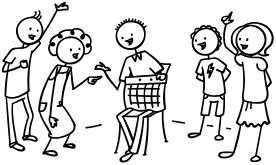 Start off by looking at a calendar with everyone (and English one, if possible). Have some fun with the calendar first: ask students to point at holidays such as Christmas and to point out their birthdays. Ask what month their birthdays are in and point to the month word (e.g. January) at the top of each month. Start to teach / elicit the English words for months as you discuss their birthdays. Ask what month it is now as well as the following (using the calendar):
Start off by looking at a calendar with everyone (and English one, if possible). Have some fun with the calendar first: ask students to point at holidays such as Christmas and to point out their birthdays. Ask what month their birthdays are in and point to the month word (e.g. January) at the top of each month. Start to teach / elicit the English words for months as you discuss their birthdays. Ask what month it is now as well as the following (using the calendar):
2. Play "Put the months in order"
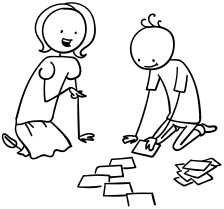 Before class, prepare some colored rectangles of card and write the months of the year in thick marker pen on each rectangle of card. You’ll be putting students in pairs so make enough sets for each pair. Also, if each month can be written on a different colored card it will help the students to quickly identify each month. Put your students in pairs and give each pair a set of mixed up cards. By referring to the calendar, have the pairs put the months in order on the floor or table. Then get everyone to touch each card and repeat after you as you chorus the months of the year paying special attention to the fist letter of each word (e.g. "J" for "January"). Run through a few times, getting faster and faster. Finally, get the pairs to mix up the cards and tell them they are going to race to see which pair can put their cards in order first. Say “Ready, steady, go!” and let the students put the cards in order.
Before class, prepare some colored rectangles of card and write the months of the year in thick marker pen on each rectangle of card. You’ll be putting students in pairs so make enough sets for each pair. Also, if each month can be written on a different colored card it will help the students to quickly identify each month. Put your students in pairs and give each pair a set of mixed up cards. By referring to the calendar, have the pairs put the months in order on the floor or table. Then get everyone to touch each card and repeat after you as you chorus the months of the year paying special attention to the fist letter of each word (e.g. "J" for "January"). Run through a few times, getting faster and faster. Finally, get the pairs to mix up the cards and tell them they are going to race to see which pair can put their cards in order first. Say “Ready, steady, go!” and let the students put the cards in order.
3. Play "Wall Touch"
Give each pair some Blue-Tak or something to stick the cards on the wall with. Ask everyone to randomly stick their cards all over the walls around the room. Then bring everyone into the middle of the room. Shout out "January" and everyone has to race over to a January card and touch it. Then “February” and so on (in the correct order) until you make it through all the months. Play another round, this time faster.
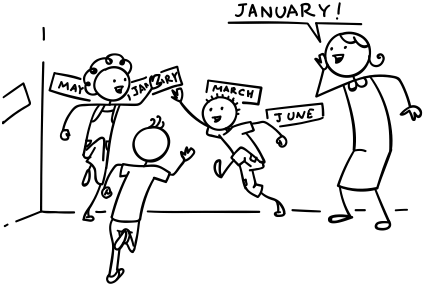
4. Sing the "Months March" song
Put one set of months cards on the board in the correct order (or use our song poster). Get everyone to stand to attention, like soldiers, and then follow the steps in the "Gestures for Months March" shown below. If this is the first time to sing the song, play it at least twice and let everyone enjoy marching around.
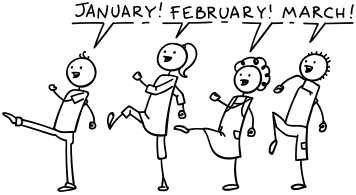 Lyrics for "Months March"
Lyrics for "Months March"
Ready … March!
January (January)
February (February)
March (March)
April (April)
May (May)
June (June)
July (July)
August (August)
September (September)
October (October)
November (November)
December (December)
Everybody … Stop!
Ready … March!
January, February, March, April, May, June, July, August, September, October, November, December.
Everybody … Stop!
Gestures for "Months March"
The actions are very simple for the song:
If you have a large room with plenty of space for everyone to march around:
If you only have a small room or don’t have much space:
Follow the same steps as above but get everyone to march on the spot.
We also have a video that you can stream in class to sing along with (Internet connection required):
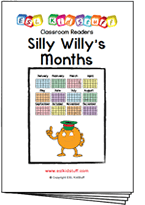 5. Read classroom reader "Silly Willy's Months"
5. Read classroom reader "Silly Willy's Months"
Let's follow the song with a reader which uses the all of the months vocabulary. Before class, download and print off the reader "Silly Willy's Months". As you go through each page, point to the pictures and elicit the months, as well as other vocab including weather and the things the characters are doing, for example:
Teacher: (pointing at the picture on page 3) Look at Silly Willy! What is he doing?
Students: Sunbathing!
Teacher: Yes, that's right! But is it hot?
Students: No, it's cold. It's snowing.
Teacher: Yes, that's right! Silly, Silly Willy! So, what month do you think it is when it's snowing?
Students: January?
Teacher: Let's check (reading) "Where Silly Willy lives, January and February are very cold. But Silly Willy likes to sunbathe!". So it's January and February.
Get the students really involved in the story by asking lots of questions about the weather during different months and activities they do (and don't do) in their country, for example:
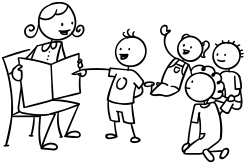 Teacher: Do you like to sunbathe in January and February?
Teacher: Do you like to sunbathe in January and February?
Students: No!
Teacher: Why not? What is the weather like here in January and February?
Students: It's cold and rainy.
Teacher: So, when do you like to sunbathe?
Students: In August.
etc.
After reading the story, give out a reader worksheet to each student and have everyone try to remember which months Silly Willy did the different things. Then read through the story one more time (without stopping for questions, etc.) and check through the answers as a class.
---
Alternatively, watch our video version of the reader (Internet connection required):
6. Do "Months Order" worksheet
Give out the "Months Order" worksheet to each student. As your students are doing their worksheets, circulate and ask questions (e.g. “What month is it?”, etc.).
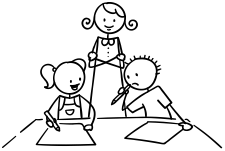
1. Assign Homework: "Months Scramble" worksheet.
2. Wrap up the lesson with some ideas from our "Warm Up & Wrap Up" page.
 Found a mistake?
Found a mistake?
Please let us know
Full access to all resources on ESL KidStuff including lesson plans, flashcards, worksheets, craft sheets,
song downloads, classroom readers, flashcards app and songs app.